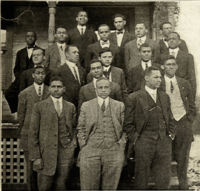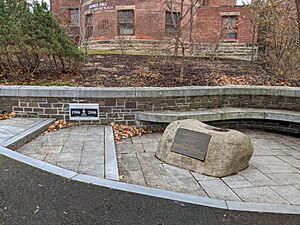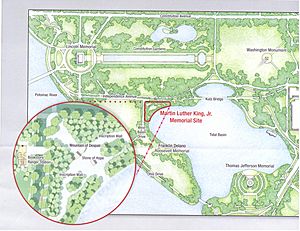Alpha Phi Alpha facts for kids
Quick facts for kids Alpha Phi Alpha |
|
|---|---|
| ΑΦΑ | |
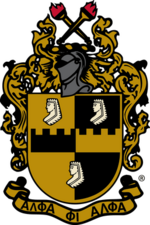 |
|
| Founded | December 4, 1906 Cornell University |
| Type | Social fraternity |
| Affiliation | NPHC and NIC |
| Emphasis | African American |
| Scope | International |
| Motto | "First of All, Servants of All, We Shall Transcend All" |
| Pillars | Manly Deeds, Scholarship, and Love For All Mankind |
| Colors | Old Gold and Black |
| Symbol | Sphinx |
| Flower | Yellow rose |
| Publication | The Sphinx |
| Chapters | 900+ |
| Members | 290,000+ lifetime |
| Nicknames | Alphas, Ice Cold Brothas, The Oldest & The Coldest, Men of Distinction |
| Headquarters | 2313 Saint Paul Street Baltimore, Maryland 21218 United States |
Alpha Phi Alpha Fraternity, Inc. (ΑΦΑ) is the first college fraternity started for African American men. It began as a club for studying and socializing at Cornell University in 1905. On December 4, 1906, it officially became a fraternity.
The fraternity's symbol is the Great Sphinx of Giza from Ancient Egypt. Its goals are "Manly Deeds, Scholarship, and Love For All Mankind." The group's motto is "First of All, Servants of All, We Shall Transcend All." Since 1945, the fraternity has welcomed men of all races. Today, it has over 290,000 members in more than 730 chapters around the world.
Alpha Phi Alpha is known for its community service. It played an important role during the Great Depression, the World Wars, and the Civil Rights Movement. The fraternity works on important issues like housing, education, and voting rights.
Many famous leaders have been members. This includes Dr. Martin Luther King Jr., W. E. B. Du Bois, and Supreme Court Justice Thurgood Marshall. Other members include Olympic champion Jesse Owens and musician Lionel Richie. The fraternity also led the effort to build the Martin Luther King Jr. Memorial in Washington, D.C.
Contents
The Story of Alpha Phi Alpha
How It All Started
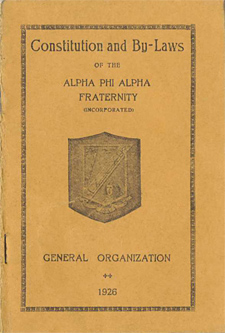
In the early 1900s, African American students at many universities were not allowed to join fraternities. At Cornell University, a student named Charles Cardoza Poindexter started a study group for Black students. They met to discuss books and support each other.
The group debated whether to become a social club or a fraternity. Some members wanted an official fraternity with Greek letters. On October 23, 1906, they chose the name Alpha Phi Alpha and the colors old gold and black.
On December 4, 1906, the group officially became a fraternity. The seven founders, known as the "Seven Jewels," were Henry Arthur Callis, Charles Henry Chapman, Eugene Kinckle Jones, George Biddle Kelley, Nathaniel Allison Murray, Robert Harold Ogle, and Vertner Woodson Tandy.
Growing Across the Country
After the first chapter at Cornell, Alpha Phi Alpha quickly grew. New chapters started at Howard University and Virginia Union University in 1907. In 1908, the first international chapter opened at the University of Toronto in Canada.
The first big meeting, or general convention, was held at Howard University in 1908. This is where the members created their official rules and traditions. The fraternity also started a magazine called The Sphinx in 1914. It is one of the oldest Black journals in the United States.
During World War I, the fraternity pushed the government to create training camps for Black officers. Many Alpha men served bravely in the war.
Serving the Community

Alpha Phi Alpha has always focused on helping others. In 1919, it started its first national program, "Go-To-High School, Go-to-College." This program encouraged young African Americans to pursue education.
During the Great Depression in the 1930s, the fraternity helped communities in need. Members like Rayford Logan advised President Franklin D. Roosevelt on issues affecting African Americans.
The fraternity also fought for voting rights. They created the famous slogan, "A Voteless People is a Hopeless People." They worked to register Black voters long before the major civil rights efforts of the 1960s.
Fighting for Civil Rights
Alpha Phi Alpha members were leaders in the fight against racial segregation. Lawyers like Thurgood Marshall and Charles Hamilton Houston argued important court cases. Their work led to the famous Brown v. Board of Education decision in 1954, which made segregation in public schools illegal.
In 1945, the fraternity officially opened its membership to men of all races. This showed its commitment to equality.
During the 1950s and 1960s, Alpha men like Dr. Martin Luther King Jr. led the Civil Rights Movement. They organized marches, boycotts, and protests to demand equal rights for all Americans. After Dr. King's death in 1968, the fraternity began the project to build a memorial for him in Washington, D.C.
Modern Times
In recent decades, Alpha Phi Alpha has continued its work. The fraternity has built affordable housing for low-income families. It also started the World Policy Council, a group that studies important global issues.
In 2006, the fraternity celebrated its 100th anniversary. Thousands of members gathered in Washington, D.C. to honor its history and plan for the future.
Today, Alpha Phi Alpha is still focused on its mission. It helps with disaster relief, such as after the 2010 Haiti earthquake. It also continues to promote education, leadership, and service around the world.
National Programs
Alpha Phi Alpha runs several key programs to help communities. These programs focus on education, leadership, and social action.
Go-To-High School, Go-To-College
This program started in 1922. It encourages young people to finish high school and go to college. Fraternity members act as mentors and role models for students.
A Voteless People is a Hopeless People
This program focuses on voter education and registration. It started in the 1930s to help African Americans exercise their right to vote. The fraternity still uses this slogan today to encourage people to participate in elections.
Project Alpha
Started in 1980 with the March of Dimes, Project Alpha is a program for young men. It provides information about responsible choices.
Special Projects
Martin Luther King Jr. Memorial
One of the fraternity's biggest achievements is the Martin Luther King Jr. Memorial. Dr. King was a member of Alpha Phi Alpha. After he passed away, the fraternity decided to build a monument in his honor.
They started a foundation to raise money and manage the project. In 1996, the U.S. Congress approved the plan. The memorial is located on the National Mall in Washington, D.C. It opened to the public in 2011.
World Policy Council
The World Policy Council was created in 1996. It is a group of experts who study and write about important world issues. The council helps the fraternity and the public understand complex topics like global health and politics.
Membership
Alpha Phi Alpha has more than 290,000 members in over 900 chapters worldwide. These chapters are in the United States, the Caribbean, Europe, Asia, and Africa.
How to Join
To join Alpha Phi Alpha, a person goes through the Initial Membership Development Process (IMDP). This is a period where candidates learn about the fraternity's history and values. The fraternity has a strict policy against hazing or any harmful activities during this process.
Famous Members
Many Alpha Phi Alpha members have become famous leaders and pioneers.
- Martin Luther King Jr.: A leader of the Civil Rights Movement and Nobel Peace Prize winner.
- Thurgood Marshall: The first African American Justice on the Supreme Court of the United States.
- W. E. B. Du Bois: A famous scholar, writer, and co-founder of the NAACP.
- Jesse Owens: An Olympic track and field star who won four gold medals in 1936.
- Duke Ellington: A legendary jazz composer and bandleader.
- Andrew Young: A civil rights leader, former U.S. Congressman, and Ambassador to the United Nations.
- Cornel West: A well-known professor and activist.
- Barry Jenkins: An Academy Award-winning film director.
Egyptian Symbols
Alpha Phi Alpha uses symbols from Ancient Egypt. This is different from many other Greek-letter groups, which use themes from Ancient Greece. The fraternity chose Egyptian symbols to connect with its African heritage.
The main symbol is the Great Sphinx of Giza. The Sphinx was carved from a single, large stone. This represents the unity and strength of the fraternity. Other symbols include the Great Pyramids. These images remind members of their strong foundation and history.
Images for kids



